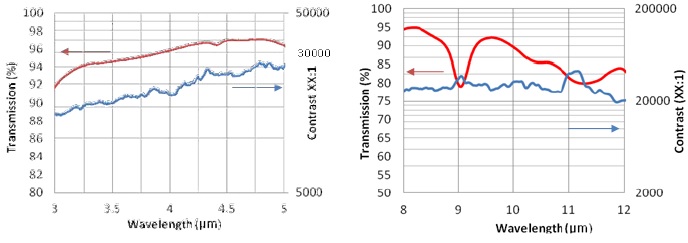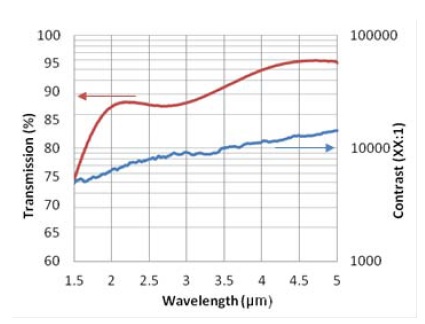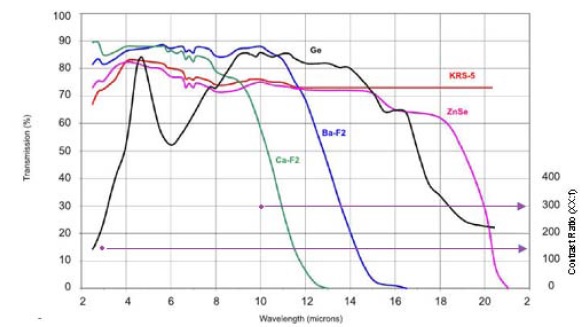Andrew Housman, ISP Optics, Irvington, NY. ahousman@ispoptics.com
May 07, 2014
The advantage of polarizers in imaging applications has been known for nearly a century and it's use has been wide spread in visible photography since Edwin Land's research into the area at Harvard and his founding of Polaroid Corporation in the 1930s. Polarizers can be used to reduce reflections from glass surfaces and bodies of water and eliminate glare in brightly lit areas.
In infrared photography, contrast ratios have been limited to a few hundred to one. The options have largely been limited in the infrared region to holographic and ruled wire-grid polarizers which only provide up to 300:1 contrast ratio for select wavelengths and reduced transmission in the passing state (Figure 1).
By comparison, visible polarizers were able to achieve contrast ratios in the thousands. There is a desire for polarizers in the mid-wave and long-wave infrared regions that can provide contrast ratios in the 10,000:1 range. Fresh on the market are high-contrast wire-grid polarizers capable of just that.
Recent advances in the application of narrower aluminum ribs allow for a finer pitch, going from sub-micron wires to nanometer scale wires. Light that is incident on the aluminum grid with its electric field oriented perpendicular to the array are unable to induce current along the ribs and pass through without being absorbed. Light incident with its electric field parallel to the ribs induce current in the wires, interacting with them as they would continuous metal and reflecting off the surface. The narrowing of the pitch size of the wire grid improves their performance, allowing for improved transmission in the passing orientation and a superior extinction ratio.
The polarizers receive an anti-reflection coating for maximum performance in their passing orientation for the mid-wave and long-wave bands. The average transmission for the 3-5 um and 8-12 um polarizers are 95.5% and 88%, respectively, outperforming their holographic counterparts. The contrast ratios are significantly improved averaging 19,500:1 (42.9 dB) and 29,000:1 (44.6 dB), respectively (Figure 2).

Figure 2 - Transmission (Red) and Contrast (Blue) for Xtreme High-Contrast Infrared Wire-Grid Polarizer POL-3-5-SI (Left) and Xtreme High-Contrast Infrared Wire-Grid Polarizer POL-8-12-SI (Right)
The use of anti-reflection coatings to enhance the performance of the polarizers combined with an institution capable of providing high-quality custom coatings on demand allows the production of shifted bands, broader bands, and tailored bands. ISP Optics carries, as part of their catalog, polarizers with high contrast ratios for the 1.5-5 μm, providing utility for the short-wave and the mid-wave portions of the infrared spectrum. The average transmission is 90% over this broader range for light polarized in the passing orientation and an average contrast ratio of more than 10,000:1 (40 dB) (Figure 3).

Figure 3 - Transmission (Red) and Contrast (Blue) for Xtreme High-Contrast Infrared Wire-Grid Polarizer POL-1.5-5-SI
This technology can have applications beyond that of imaging and polarization analysis. The reflection of the blocked polarization (as opposed to absorption), the high efficiency and contrast ratio, and the ability to perform coatings for custom wavelength ranges and angles of incidence open up the use of these as polarizing beamsplitters - or better yet, beam combiners - with early results tested with the standard polarizer showing more than 30 dB of contrast at 45 degrees and modeling indicating potential performance over 40 dB. Quantum Cascade Lasers are inherently polarized (about 100:1) and with narrow linewidths throughout the mid-wave and long-wave regions. The use of a high-contrast infrared polarizer enables the combination of multiple beams without requiring steep dichroic mirrors.
Works Cited
[1] "Holographic Wiregrid Polarizer," [Online]. Available: http://www.optometrics.com/holographic-wire-grid-polarizers. [Accessed 30 04 2014].















